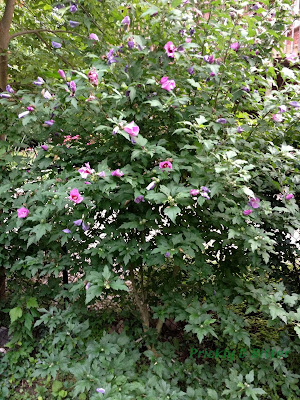Species name: Hibiscus syriacus
Common name: rose of Sharon, rose mallow
Location: my back yard (London, Ontario)
I personally love this shrub, but it illustrates how the term "invasive" is only meaningful to a small geographic location, and is certainly not a broad-reaching term. Most horticultural experts would say that this plant has the potential to become invasive, but only in areas where growing conditions are ideal (usually significantly further south than where I am). Well, obviously growing conditions are ideal here; this shrub is now taller than I am (and pruned every year) and wasn't there when we first moved into the house in 2006 (the neighbours have one that's probably 20 feet tall now; it's gigantic!). Pretty impressive for a shrub that was once considered to be intolerant to frost, so much so that people in Britain were strongly suggested against planting it in their garden but rather overwintering the plant indoors in the warm cellar. When Linnaeus (the grandfather of plant taxonomy or the naming of plants) first discovered this plant in the 1700s he knew it was native to Asia, but was convinced that the native range extended from the area now known as China and Korea all the way to the west to Syria (where he named the plant after). Unfortunately, his native range was a bit off and we now know that it doesn't extend much further west than India. The plant has been naturalized in many areas of the world now, ranging as far north as England (and Canada, for that matter) and as far west as Spain and Portugal. The flowers are very short-lived, so enjoy them on the plant while they last; typically a single flower bloom will be dead by the evening of the next day, but thousands of flower buds are produced on the plant in a single growing season. There's never much time during the summer where the plant isn't in full bloom. It shouldn't be surprising that this plant is one of the favourite food plants of those ugly "June bugs" that invade at the beginning of the summer; the plant and the bug are both originally from the same area of the world.
This plant is a great example of why I hate referring to plants exclusively by their common names. The common name "Rose of Sharon" can be used to refer to many plants, and this mostly depends on what era you're living in. Today, that common name is usually applied to this plant, the rose mallow, but other times it is also used to refer to an evergreen shrub with tiny yellow flowers native to Europe and southeast Asia (that is completely unrelated, might I add). In biblical times, the term "Rose of Sharon" was used to refer to at least four different plants depending on your geographic location: it could be a crocus growing on the Plain of Sharon, a tulip-like plant with bright red flowers growing in abundance in the Hills of Sharon, the Sharon tulip (a species of the genus Tulipa that is no longer grown in abundance as an ornamental species; in fact it is now quite rare), or the plant that we now refer to as the Madonna lily. But, of course, interpretations of the Bible change, and now most biblical scholars have agreed that the name "rose of Sharon" is actually a mistranslation from Hebrew and should actually be "crocus of Sharon" if you're referring to the biblical plant, and is actually referring to the now critically endangered plant known as the sand daffodil or the Lily of St. Nicholas which is neither a daffodil, nor lily, nor is it a crocus. So! Can we all agree that common names are silly? :)
The "real" rose of Sharon, at least my version of the rose of Sharon, is a plant that is of great importance to the people of South Korea (perhaps North Korea, too, but finding out for sure is obviously problematic). The flower of this plant is the national flower of South Korea, and it is also believed that it is an important medicinal plant. Traditional Korean medicine uses the flowers and leaves of this plant brewed in a tea to ensure eternal life (whether this is actual eternal life or proverbial eternal life I'm not sure), and the leaves and flowers are also commonly eaten during special events or special ceremonies. I've tried chewing a bit on the leaves of this plant and find it...unpalatable at best. With Korean food being as spicy as it is, I find it hard to believe you could pick out the flavour of the leaves, but that might change with cooking (and they might be used in mild dishes, too. I'm not sure). I still haven't brought myself to try eating a flower; the thought of eating flowers still seems like a botanical injustice to me. Why would I want to eat something so pretty?!






No comments:
Post a Comment